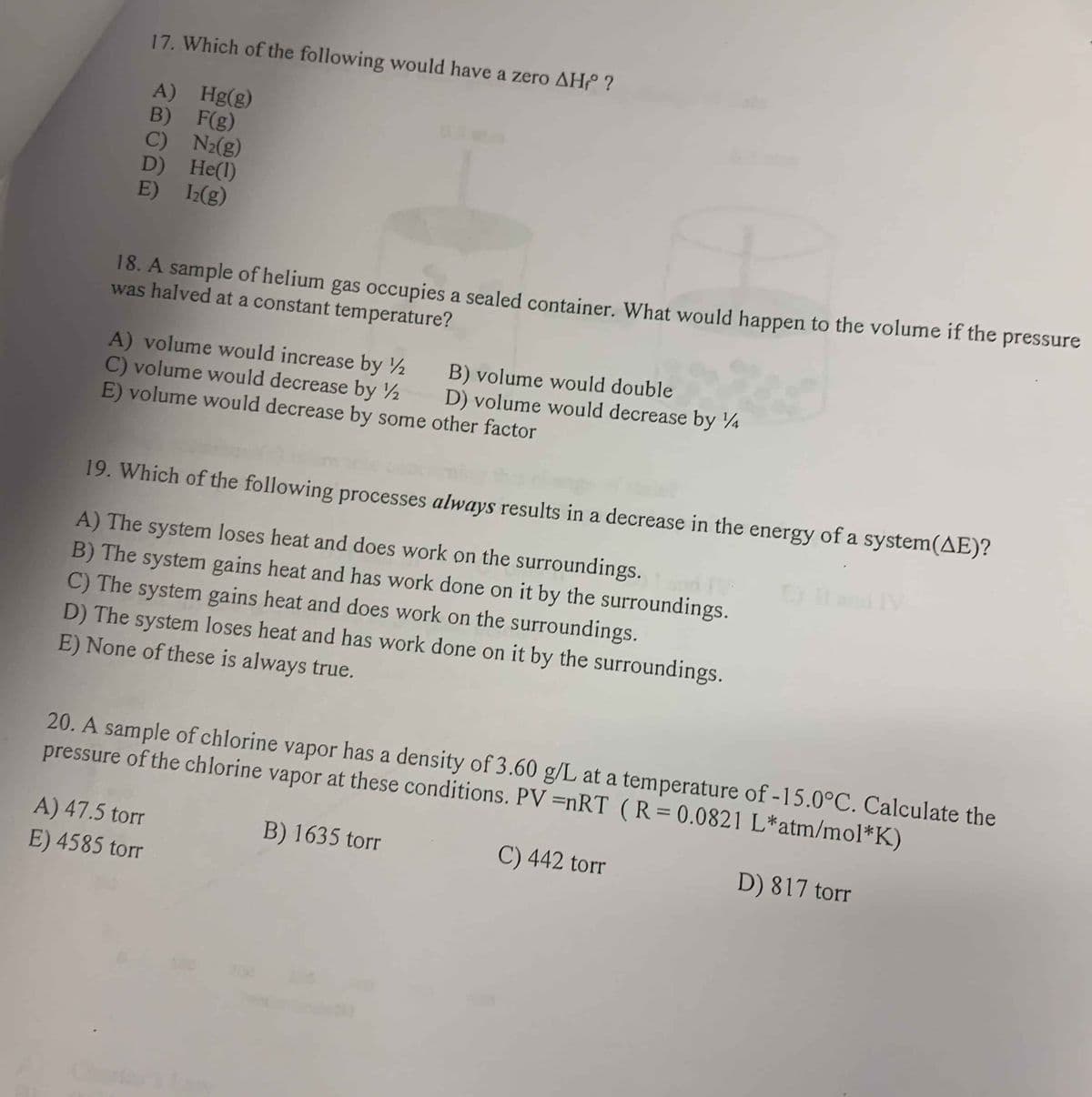Chapter5: Gases
Section: Chapter Questions
Problem 108E
Related questions
Question

Transcribed Image Text:17. Which of the following would have a zero AH°?
A) Hg(g)
B) F(g)
C) N2(g)
D) He(1)
E) 12(g)
18. A sample of helium gas occupies a sealed container. What would happen to the volume if the pressure
was halved at a constant temperature?
A) volume would increase by 12
B) volume would double
C) volume would decrease by ½
D) volume would decrease by
E) volume would decrease by some other factor
19. Which of the following processes always results in a decrease in the energy of a system(AE)?
A) The system loses heat and does work on the surroundings.
E)
B) The system gains heat and has work done on it by the surroundings.
C) The system gains heat and does work on the surroundings.
D) The system loses heat and has work done on it by the surroundings.
E) None of these is always true.
20. A sample of chlorine vapor has a density of 3.60 g/L at a temperature of -15.0°C. Calculate the
pressure of the chlorine vapor at these conditions. PV =nRT (R = 0.0821 L*atm/mol*K)
A) 47.5 torr
E) 4585 torr
B) 1635 torr
C) 442 torr
D) 817 torr
Expert Solution
This question has been solved!
Explore an expertly crafted, step-by-step solution for a thorough understanding of key concepts.
Step by step
Solved in 4 steps with 3 images

Knowledge Booster
Learn more about
Need a deep-dive on the concept behind this application? Look no further. Learn more about this topic, chemistry and related others by exploring similar questions and additional content below.Recommended textbooks for you


Chemistry
Chemistry
ISBN:
9781305957404
Author:
Steven S. Zumdahl, Susan A. Zumdahl, Donald J. DeCoste
Publisher:
Cengage Learning

Introductory Chemistry: A Foundation
Chemistry
ISBN:
9781337399425
Author:
Steven S. Zumdahl, Donald J. DeCoste
Publisher:
Cengage Learning


Chemistry
Chemistry
ISBN:
9781305957404
Author:
Steven S. Zumdahl, Susan A. Zumdahl, Donald J. DeCoste
Publisher:
Cengage Learning

Introductory Chemistry: A Foundation
Chemistry
ISBN:
9781337399425
Author:
Steven S. Zumdahl, Donald J. DeCoste
Publisher:
Cengage Learning

Chemistry: An Atoms First Approach
Chemistry
ISBN:
9781305079243
Author:
Steven S. Zumdahl, Susan A. Zumdahl
Publisher:
Cengage Learning

Chemistry: The Molecular Science
Chemistry
ISBN:
9781285199047
Author:
John W. Moore, Conrad L. Stanitski
Publisher:
Cengage Learning

Chemistry & Chemical Reactivity
Chemistry
ISBN:
9781133949640
Author:
John C. Kotz, Paul M. Treichel, John Townsend, David Treichel
Publisher:
Cengage Learning